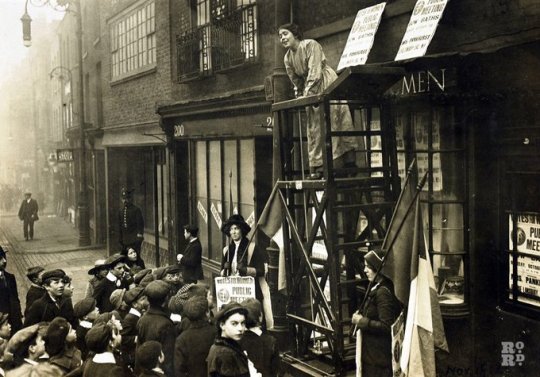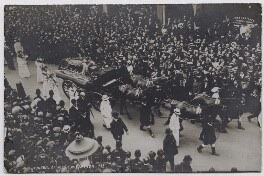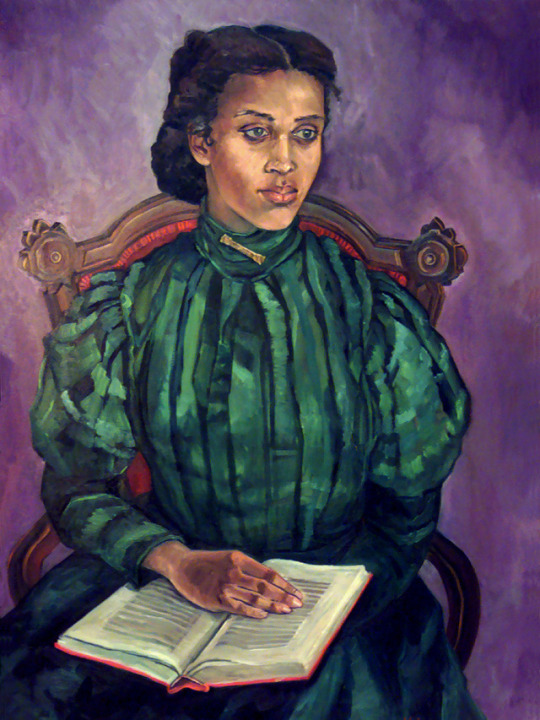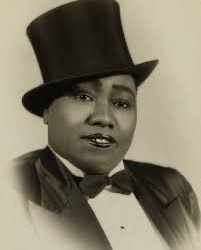Text


Alexandra Kollontai
Russian revolutionary, politician, diplomat and Marxist, the first woman to be a cabinet minister and ambassador, and a key figure in Marxist feminism.
She is buried in Novodevichye Cemetery, Moscow, Russia.
0 notes
Text

Sylvia Pankhurst is buried in front of Trinity Cathedral, Addis Ababa, Ethiopia.
Yesterday marked the death of Sylvia Pankhurst - one of the finest revolutionary communists to have ever graced Britain's shores. We have rarely seen such fighters on this earth.

Sylvia was the most tortured suffragette, targetted for her insistence on including working class women within the demands of women's suffrage (much to the disdain of her mother and sister). She did not balk against repeated forced feeding, hunger striking and sleep striking.
She was one of a handful of communists in Britain who opposed the first world war. Her criticism of the war was ceaseless. Practically isolated, she organised relief for working class people in London with cost-price restaurants, free child care for mothers, and more.
She broke with the Labour Party over this, and never returned despite the enormous pressure put upon her by the British labour movement and, later, the Third Internationale. Her arguments with Lenin remain a key debate in communist and British politics.
Pankhurst stood resolutely with the Bolshevik revolution at its outbreak, and was pivotal in organising the "Hands Off Russia" campaign in Britain - which culminated in dock workers across the country refusing to load any munitions to ships.
Pankhurst was an outspoken opponent of racism. Her newspaper - then the Worker's Dreadnought - was the first newspaper in Britain to hire black journalists. When articles written by the Jamaican journalist, Claude McKay, were viewed as seditious, she went to jail for him.

Her support for Irish independence never wavered. She supported Larkin, the Irish Transport and General Workers' Union and United Builders' Labourers Union during the Dublin lock-outs. She stood by the Irish Citizen Army during the Easter Rising.
She was one of the first in Britain to recognise the dangers of fascism, her warnings and agitation beginning as early as 1920. Through this struggle, she became deeply involved in Ethiopian national liberation, where she spent the last years of her life.
All of this is just the tip of the iceberg of the contributions Sylvia made in her life. She did all of this at great cost to herself, enduring her mother and sister denouncing her in the press repeatedly, endless slander, rejection by the mainstream communist movement and worse.

Sylvia also belongs to the great pantheon of disabled revolutionaries, being diagnosed with endometriosis whilst in prison. This, along with the damage done to her organs by forced feeding, left her with often crippling stomach problems.
"I am going to fight capitalism even if it kills me. It is wrong that people like you should be comfortable and well fed while all around you people are starving." She fought until she died, but capitalism didn't kill her. At aged 78, Sylvia passed on.
She was given a state funeral in Ethiopia, and remains the only foreigner buried in the front of Holy Trinity Cathedral. An Ethiopian migrant, cited anonymously in Rachel Holmes' biography of Pankhurst, summed up what she meant to him thus:
"After God, Sylvia Pankhurst".

To learn more about Sylvia, we highly recommend Rachel Holmes' biography, "Sylvia Pankhurst: Natural Born Rebel".
95 notes
·
View notes
Text
Emmy Noether is buried in The Cloisters at Bryn Mawr College, Bryn Mawr, Montgomery County, Pennsylvania, USA.
Emmy Noether
Not particularly well-known, especially outside scientific circles, Amelia Emmy Noether’s life path is the most accurate example of what women had to go through at the beginning of the twentieth century. Her complex work has been extremely revolutionary in the fields of mathematics and physics. She became “a founder of abstract algebra” when she developed theories of rings and fields as well as the absolute theory of ideals.
She put forth a unified theory of non-commutative algebra and representation theory and, with colleagues Helmut Hasse and Richard Brauer, Noether deduced that each simple algebra over an algebraic number field is cyclic. However, her most significant contribution was to theoretical physics, which has been recognized as “certainly one of the most important mathematical theorems ever proved in guiding the development of modern physics”. The theorem, still known by her name nowadays (Noether’s theorem) explains the fundamental relation between symmetry and conservation law. Put simply, every differentiable symmetry in nature has a corresponding conservation law, which implies that there is a measurable quantity that is not changing in any physical process or time, a conserved quantity. Her theorem was immediately recognized to be of fundamental importance.
52 notes
·
View notes
Photo
Madeleine Pelletier is buried in Perray-Vaucluse Asylum Cemetery, Ile-de-France, France.

On this day, 29 December 1939, French physician, libertarian socialist and women’s rights activist Madeleine Pelletier died in an asylum where she had been interned after opening assisting an abortion for a teenage survivor of incest. Born into a poor family in 1874, Pelletier became a feminist and socialist, and was arrested for breaking a window at a polling place after she and other women were denied entry. While never admitted into intellectual circles, she was a pioneer of advanced feminist ideas, like gender roles being largely determined by society, rather than biology. While expressing no interest in sex in her personal life, Pelletier advocated for women’s rights to sexual pleasure, as well as to contraception and abortion. Despite all the misfortune in her life, Pelletier declared: “I remain a feminist. I will remain one until my death even though I don’t like women as they are now any more than I like the working class as it is. Slave mentalities revolt me.” https://www.facebook.com/workingclasshistory/photos/a.296224173896073/1618146305037180/?type=3
2K notes
·
View notes
Photo
Josephine Cochran is buried in Glenwood Cemetery, Illinois, USA.

Josephine Garis Cochran (sometimes spelled Cochrane) (1839-1913) is largely unknown now, but she should be declared the patron saint of the modern busy family. For in 1886, she patented the first commercial dishwasher.
Cochran wanted a machine that would save time washing dishes, and would prevent broken crockery. She was convinced that there had to be a mechanical solution to the tedium of dishwashing. Josephine grew up in a family of engineers, but finding no one that could or would invent such a machine, she vowed, “If nobody else is going to invent a dishwashing machine, I’ll do it myself.”
So she invented a contraption of gears, belts, and pulleys that could take a cage filled with over 200 dirty dishes, and would re-appear a few minutes later with the dishes as clean as if they had been hand-washed. Her machine, unlike others that had been attempted, was the first to use water pressure rather than scrubbers to clean the dishes. It also had fitted racks to hold the dishes and cutlery in place.
Once her patent application, under the name of “J.G. Cochran” was approved, the next challenge was production. “I couldn’t get men to do the things I wanted in my way until they had tried and failed in their own,” Josephine later explained. “And that was costly for me. They knew I knew nothing, academically, about mechanics, and they insisted on having their own way with my invention until they convinced themselves my way was the better, no matter how I had arrived at it.”
In 1886, with the aid of a young mechanic named George Butters, she set to work in a woodshed behind her home bringing the first prototype to life.
Once she had the patent and a machine, she had to sell the dishwashers. Although she wanted to sell directly to women, as they would appreciate how much drudgery the machine eliminated, because very few households in the 19th century could afford to pay over $100 for an appliance, her main customers were large hotels and restaurants.
She was successful at sales, but it was very difficult to challenge the mores of the 19th century, to enter these establishments on her own. When discussing selling to a large hotel, she described it as “almost the hardest thing I ever did, I think, crossing the great lobby of the Sherman House alone. You cannot imagine what it was like in those days…for a woman to cross a hotel lobby alone. I had never been anywhere without my husband or father—the lobby seemed a mile wide. I thought I should faint at every step, but I didn’t—and I got an $800 order as my reward.”
In 1893, she exhibited her dishwashers at the Columbian Exhibition World’s Fair in Chicago, and the orders came pouring in from schools, colleges, hospitals and other large institutions. Her product, the Garis-Cochran Dishwasher was a success.
With the assistance of her business partner, George Butters, they opened a factory in 1898, Cochran’s Crescent Washing Machine Company. At first the dishwashing machines were used primarily by large businesses and institutions, but decades later, Cochran’s invention eventually evolved into the appliance considered essential by millions of householders today.
Cochran died of a stroke in 1913, a very successful businesswoman. Her company was bought out in 1926 by the Hobart Corporation which produced appliances under the KitchenAid brand. In 1986, KitchenAid was acquired by Whirlpool.
Josephine Garis Cochran was inducted into the National Inventors Hall of Fame in 2006. In 2013, on the 100 year anniversary of her death, the country of Romania (a country with which Cochran had no connection) issued a postage stamp in her honor, an indication of just how widespread her influence was.
16 notes
·
View notes
Text
Bertha Pappenheim is buried in Alter Jüdischer Friedhof, Frankfurt am Main, Hessen, Germany.

“Over time, Freud’s repudiation of the traumatic theory of hysteria did take on a peculiarly dogmatic quality. The man who had pursued the investigation the furthest and grasped its implications the most completely retreated in later life into the most rigid denial. In the process, he disavowed his female patients. Though he continued to focus on his patients’ sexual lives, he no longer acknowledged the exploitative nature of women’s real experiences. With a stubborn persistence that drove him into ever greater convolutions of theory, he insisted that women imagined and longed for the abusive sexual encounters of which they complained. He went on to develop a theory of human development in which the inferiority and mendacity of women are fundamental points of doctrine. In an antifeminist political climate, this theory prospered and thrived.
The only one of the early investigators who carried the exploration of hysteria to its logical conclusion was Breuer’s patient Anna O. After Breuer abandoned her, she apparently remained ill for several years. And then she recovered. The mute hysteric who had invented the “talking cure” found her voice, and her sanity, in the women’s liberation movement. Under a pseudonym, Paul Berthold, she translated into German the classic treatise by Mary Wollstonecraft, A Vindication of the Rights of Women, and authored a play, Women’s Rights. Under her own name, Bertha Pappenheim became a prominent feminist social worker, intellectual, and organizer. In the course of a long and fruitful career she directed an orphanage for girls, founded a feminist organization for Jewish women, and traveled throughout Europe and the Middle East to campaign against the sexual exploitation of women and children. Her dedication, energy, and commitment were legendary. In the words of a colleague, “A volcano lived in this woman… . Her fight against the abuse of women and children was almost a physically felt pain for her.” In her will, she expressed the wish that those who visited her grave would leave a small stone, “as a quiet promise … to serve the mission of women’s duties and women’s joy … unflinchingly and courageously.””
- Trauma and Recovery by Judith Herman
85 notes
·
View notes
Photo
Fannie Lou Hamer was an American voting and women's rights activist, community organizer, and leader in the civil rights movement, known for her work against disenfranchisement as well as coining the phrase ‘Mississippi appendectomy’ to refer to forced sterilisation.
She is buried in the Fannie Lou Hamer Memorial Garden, Ruleville, Mississippi, USA.

Fannie Lou Hamer (6 October 1917 – 14 March 1977)
996 notes
·
View notes
Text
Josephine Butler, 1828-1906, was a Victorian feminist, who campaigned for women’s suffrage, education, and independent legal existence, and against child prostitution and sex trafficking.

She is memorialised with stained glass windows in Liverpool’s Anglican Cathedral and London’s St Olave’s Church, as well as the Reformer’s Memorial in Kensal Green Cemetery, London.
Josephine Butler is buried in St Gregory Churchyard, Northumberland, England.
10 notes
·
View notes
Text
Hertha Ayrton’s grave is not publicised, but she has two blue plaques in her memory, at 41 Norfolk Square, Paddington, England, and Queen Street, Portsmouth, England.

•Hertha Ayrton•
43 notes
·
View notes
Text


Emily Wilding Davison (1872 – 1913) was an English suffragette in the early 20th century. A member of the Women's Social and Political Union (WSPU) and a militant fighter for her cause, she was arrested on nine occasions, went on hunger strike seven times and was force-fed on forty-nine occasions.
She soon became known in the organisation for her daring militant action; her tactics included breaking windows, throwing stones, setting fire to postboxes, planting bombs and, on three occasions, hiding overnight in the Palace of Westminster—including on the night of the 1911 census.
She died after being hit by King George V's horse Anmer at the 1913 Epsom Derby when she walked onto the track during the race. The WSPU were quick to describe her as a martyr.
5,000 women formed the procession at her funeral, and the route was lined by 50,000 people. Her gravestone bears the WSPU slogan "Deeds not words". She is buried in St Mary the Virgin Churchyard, Northumberland, England.
5 notes
·
View notes
Text
Inge Lehmann is buried in Hørsholm Cemetery, Hovedstaden, Denmark.
Female scientist everyone should know about.
1K notes
·
View notes
Photo
Emma Goldman is buried in Forest Home Cemetery, Illinois, USA.

On this day, 11 February 1916, Lithuanian-born Jewish anarchist Emma Goldman was arrested in New York City for distributing information on birth control. She was technically charged with breaching the Comstock Act, which banned “obscene” material from the mail or from being transported across state lines. Her arrest came as Goldman was due to deliver a public lecture on family planning, which was a key concern for working class people.
Radicals argued that family planning was essential for working class people to be able to have an acceptable standard of living, and believed that authorities opposed birth control so that there would be an oversupply of labour to keep down wages and fill the army.
We have a collection of Goldman’s writings on sex and gender available here, as well as reproductions of this mugshot: https://shop.workingclasshistory.com/collections/all/emma-goldman
Pictured is a mugshot of Goldman from another arrest https://www.facebook.com/workingclasshistory/photos/a.296224173896073/1347371405448006/?type=3
900 notes
·
View notes
Photo
Dr Sarah Fraser is buried in Lincoln Memorial Cemetary, Maryland, USA.

Dr, Sarah Loguen Fraser by Susan Keeter
Sarah Marinda Loguen Fraser (29 January 1850-9 April 1933) was born to a former slave turned conductor of the Underground Railroad in 1855. Sarah decided to become a physician after seeing a young boy pinned beneath a wagon, vowing “I will never never see a human being in need of aid again and not be able to help”
She became the first American black women to earn a medical degree, the first American black female physician specializing in obstetrics and pediatrics in the United States, and the first female physician in the Dominican Republic.
1K notes
·
View notes
Text
Mary Wollstonecraft is buried in St Peter’s Church, Bournemouth, having been moved from St Pancras Churchyard, London, in 1851.
Happy birthday, Mary Wollstonecraft (b. 27 April 1759)
“My own sex, I hope, will excuse me, if I treat them like rational creatures, instead of flattering their fascinating graces, and viewing them as if they were in a state of perpetual childhood, unable to stand alone.“
- A Vindication of the Rights of Women (1792), Mary Wollstonecraft
4K notes
·
View notes
Text
Gladys Bentley is buried in Lincoln Memorial Park, California, USA.


Gladys Bently (August 12, 1907 - January 18, 1960)
Going by the stage name “Bobbie Minton”, Gladys was a lesbian blues singer in New York during the Harlem Renaissance, and was one of the most financially successful black women in the US in the 1920s and 30s.
Eldest of four, Gladys was born in Philadelphia, Pennsylvania. She had a troubled relationship with her parents, in part because her mother wished for her to have been born a boy. To quote Gladys “When they told my mother she had given birth to a girl, she refused to touch me. She wouldn't even nurse me and my grandmother had to raise me for 6 months on a bottle before they could persuade my mother to take care of her own baby.”
Growing up, she would often wear her brother’s clothes and was seen as “unladylike” or “abnormal”, which caused her parents to take her to multiple doctors in an attempt to “cure” her. It was also a source of mockery among her school mates. She felt growing up and the feeling of rejection shaped her behavior. She never wanted a man to touch her, resented her brothers, and had a crush on one of her female elementary school teachers.
Becoming a skilled pianist and singer, Gladys ran away from home at age 16, going to a New York neighborhood called Harlem. She caught word of a notoriously gay speakeasy, Clam House, who was in need of a male pianist. This is when she began to perform in “men’s” attire, and here she perfected her skills, quickly becoming popular. The club was soon renamed to “Barbara’s Exclusive Club” after her stage name, Barbara “Bobbie” Minton.
Even from the beginning, Gladys incorporated her lesbianism into her songs with innuendos, and double-entendres. Being a large, deep voiced woman, she appealed to audiences gay, straight, black, and white alike. Okeh Race Records published 8 singles by her in 1928 and 29, with her own radio program broadcasting the following year.
There is so much more to learn about Gladys Bentley, and I’m happy to have learned about her. We love her here. 💜
You can learn more about Gladys Bentley through the following sources:
https://legacyprojectchicago.org/person/gladys-bentley
https://www.smithsonianmag.com/smithsonian-institution/great-blues-singer-gladys-bentley-broke-rules-180971708/
https://www.blackpast.org/african-american-history/bentley-gladys-1907-1960/
104 notes
·
View notes
Text
Lise Meitner is buried in St James Churchyard, Hampshire, United Kingdom.
Otto Hahn won the 1944 Nobel prize of chemistry for the discovery of nuclear fission, which was a joint project with Lise Meitner. Meitner was nominated 48 times, and never won a Nobel.
3K notes
·
View notes
Photo
Dr Gisella Perl is buried in Sanhedria Cemetery, Jerusalem.

Gisella Perl was forced to work as a doctor in Auschwitz concentration camp during the holocaust.
She was ordered to report ever pregnant women do the physician Dr. Josef Mengele, who would then use the women for cruel experiments (e.g. vivisections) before killing them.
She saved hundrets of women by performing abortions on them before their pregnancy was discovered, without having access to basic medical supplies. She became known as the “Angel of Auschwitz”.
After being rescued from Bergen-Belsen concentration camp she tried to commit suicide, but survived, recovered and kept working as a gynecologist, delivering more than 3000 babies.
424K notes
·
View notes